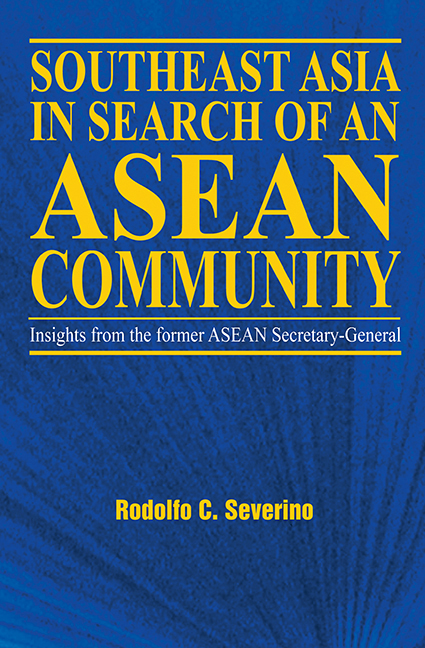Book contents
- Frontmatter
- Contents
- Foreword
- Introduction
- About the Author
- Acknowledgements
- Glossary
- 1 The “ASEAN Way”: Its Nature and Origins
- 2 Who Belongs in ASEAN? The Question of Membership
- 3 The Issue of Non-Interference
- 4 Regional Security: The ASEAN Role
- 5 Integrating the Regional Economy
- 6 ASEAN and the World
- 7 The ASEAN Community: Is It for Real?
- 8 What Kind of Future for ASEAN?
- Appendices
- A The ASEAN Declaration
- B Treaty of Amity and Cooperation in Southeast Asia
- C Agreement on the Common Effective Preferential Tariff Scheme for the ASEAN Free Trade Area
- D ASEAN Vision 2020
- E ASEAN at a Crossroads
- F Declaration of ASEAN Concord II
- G Recommendations of the High-Level Task Force on ASEAN Economic Integration
- H ASEAN Security Community Plan of Action
- I The ASEAN Socio-Cultural Community (ASCC) Plan of Action
- Interviews
- Index
E - ASEAN at a Crossroads
from Appendices
Published online by Cambridge University Press: 21 October 2015
- Frontmatter
- Contents
- Foreword
- Introduction
- About the Author
- Acknowledgements
- Glossary
- 1 The “ASEAN Way”: Its Nature and Origins
- 2 Who Belongs in ASEAN? The Question of Membership
- 3 The Issue of Non-Interference
- 4 Regional Security: The ASEAN Role
- 5 Integrating the Regional Economy
- 6 ASEAN and the World
- 7 The ASEAN Community: Is It for Real?
- 8 What Kind of Future for ASEAN?
- Appendices
- A The ASEAN Declaration
- B Treaty of Amity and Cooperation in Southeast Asia
- C Agreement on the Common Effective Preferential Tariff Scheme for the ASEAN Free Trade Area
- D ASEAN Vision 2020
- E ASEAN at a Crossroads
- F Declaration of ASEAN Concord II
- G Recommendations of the High-Level Task Force on ASEAN Economic Integration
- H ASEAN Security Community Plan of Action
- I The ASEAN Socio-Cultural Community (ASCC) Plan of Action
- Interviews
- Index
Summary
Report of Rodolfo C. Severino, Secretary-General of the Association of Southeast Asian Nations, to the 8th ASEAN Summit
Phnom Penh, 4 November 2002
Since this is my last report to Your Majesty and Your Excellencies, I should like, with your indulgence, to take a longer perspective than usual and take a glance at the past five years instead of just the last one. In any case, the report card for the past year, which Your Majesty and Your Excellencies have directed me to draw up, has been circulated.
When ASEAN's leaders kindly appointed me to the office of Secretary-General, Southeast Asia was at the height of the financial crisis of 1997–98. ASEAN was in the process of expansion, a process that was projected to place severe strains on the association. The haze from land and forest fires that was enveloping the region was testing the ability of ASEAN to work out regional solutions to regional problems. All this degraded ASEAN's image in the world, affecting the perceptions of investors and ASEAN's influence in international affairs. At the same time, the rise of certain large economies and other regional groups was posing a challenge for ASEAN in the global competition for markets and investments.
ASEAN's responses to these developments have, to some extent, mitigated their adverse impact and the negative perceptions of ASEAN. The Secretariat and other ASEAN bodies managed somewhat to reverse the slide of ASEAN's image. The association continued to help maintain regional peace and stability by sustaining its solidarity, managing the ASEAN Regional Forum, and strengthening the association's linkages with its neighbours, particularly China, Japan and Korea. The negotiations on a declaration on conduct in the South China Sea had a calming effect on this critical area. This process has concluded, and the declaration is ready for signing this afternoon. ASEAN has responded to the surge of international terrorism, adopting strong positions, taking concrete cooperative measures, and working with the international community. The recent terrorist attack in Bali has prodded ASEAN to intensify these efforts.
- Type
- Chapter
- Information
- Southeast Asia in Search of an ASEAN Community , pp. 416 - 419Publisher: ISEAS–Yusof Ishak InstitutePrint publication year: 2006

